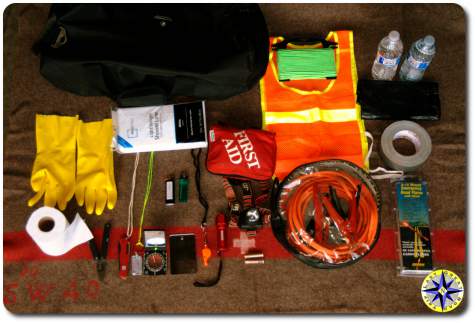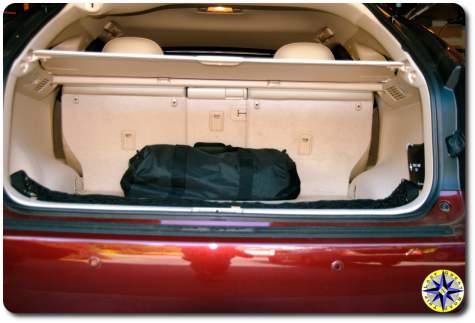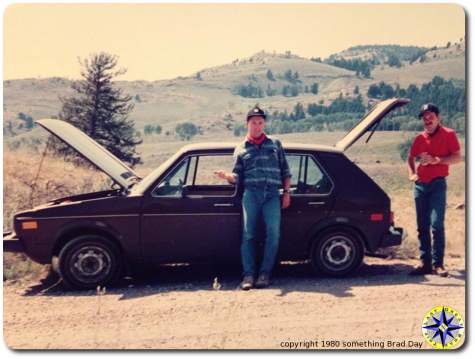 Back in the 80’s Brad and I took a road trip to Yellowstone National Park. Miles from anywhere our car’s fuel pump gave out. We were stuck on a dirt road that maybe saw another car once every day or so. Fast forward to today and I can add a couple of dead batteries, several flat tires, black ice spin out, two snow closed passes and a blown engine to the list of things that have left me stranded on the side of the road in less than ideal conditions.
Back in the 80’s Brad and I took a road trip to Yellowstone National Park. Miles from anywhere our car’s fuel pump gave out. We were stuck on a dirt road that maybe saw another car once every day or so. Fast forward to today and I can add a couple of dead batteries, several flat tires, black ice spin out, two snow closed passes and a blown engine to the list of things that have left me stranded on the side of the road in less than ideal conditions.
Changing a tire on a warm afternoon on a quiet level country road is no big deal. Changing a tire in the dark on the side of the highway when it’s 40 degrees and raining, lacks entertainment value. Over the years I have managed to put together an emergency roadside kit that takes the sting out being stuck on road and makes most bad situations bearable. These days I always have a emergency roadside kit in the trunk of all my vehicles even if I’m just going to the grocery store.
Our roadside emergency kit is easy to build up and is filled with items you probably have lying around the house.
Start with an old gym bag or duffel. Even your daughter’s pink “My Favorite Pony” school backpack will do. You just need something to keep all your supplies together. Once you have your recycled book bag in hand, gather up the following items and stuff them in.
- Jumper cables – I’m surprised at how many people with a dead battery who have asked me for a jump, follow it by “Do you have jumper cables?”.
- Wool blanket – Coming home from eastern Washington, WADOT closed the pass for avalanche control and I spent four hours waiting for the all clear under a warm blanket while the snow continued to fall. Wool retains it’s ability to keep you warm even when wet and is one of the most important items in the kit.
- Household cleaning gloves – I’ve reached into mucky wheel wells to work snow chains around a tire and pulled crow parts from the grill. Waring long, heavy duty, rubber household cleaning gloves made it much less traumatic.
- Personal first aid kit – No one enjoys driving with a throbbing headache or having you’re allergies kick into high gear as you drive by miles of hay fields. A simple first aid kit will let you take care of yourself (or one of the kids) and get you back on the road before it becomes a serious problem.
- Duct tape – You can fix anything with duct tape.
- Pocket knife / Leatherman tool – I’ve pulled out a pocket knife for just about everything including cutting duct tape in order to splint my finger after slamming it in door.
- Bottles of water – You can go for weeks without food, but you will quickly start to dehydrate in dry conditions and can die within a few days without water. I’ve also grabbed a water bottle to wash dirt out a friend’s eye when the wind kicked up, swirling dust everywhere.
- Road flares – Ever change a tire on the side of the road… in the dark? I have. It’s important to let on-coming traffic know you’re there. We like flare over reflectors since a flare can be used to start a signal fire in the wettest conditions if things really go south.
- Safety vest – It’s not much of a fashion statement but the more visible you are the better. On the side of the road or from a rescue helicopter you want to be seen.
- Whistle – Yelling for help will only be heard so far and eventually your voice will tire, but a whistle can be blown forever and is a universal call for attention.
- Compass – Ff you do have to leave your vehicle and hike out, you want to know where you’re going. A compass will let you get your bearings and trek a straight line.
- Plastic shower curtain liner – $7.00 at any Walmart and you instantly have an emergency shelter, ground tarp, rain poncho, oil catch, knelling mat for changing a tire in the mud, … There are no limits to what you can do with a plastic shower curtain liner, and it comes folded up in a neat little package that will take very little space.
- Flashlight / headlamp (and batteries) – Be sides helping you look into the dark corners of your vehicle to find a fuse you dropped, a light waving by your side as you walk down the highway to a gas station will make you visible to traffic so you don’t become a roadside memorial.
- Yard sized trash bag – From rain coat to dirty close bag to dead body disposal, the usage opportunities for a large trash bag rival that of duct tape.
- Parachute cord – This is another one of those endless use items. Lashing down a loose tarp or turning that shower curtain liner into a shelter, in an emergency the uses are only limited by your imagination.
- Toilet paper – If you’ve ever used leaves than you don’t need to ask why.
- Lighters/matches/magnesium fire stick – You’ll need something to lite a fire if you are really in a bad situation and need a fire.
While these are the basics that should be in your emergency travel kit, there is plenty of room to personalize it with your own flare. Consider what your family needs are and plan accordingly to include other useful items such as: baby wipes, signal mirror, towel, travel pillow, rubber boots, work gloves or a good book to kill time while you wait for the tow truck. If you need other ideas take a look at the Red Cross’ survival kits.
Years of road trips have taught us that being prepared means being equipped with the proper supplies that you may need in the event of a road trip emergency or just a flat tire in the rain.

